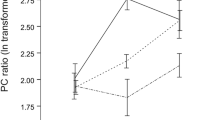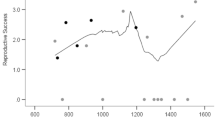Abstract
The urinary volatiles from dominant and subordinate male mice were chromatographically compared, both immediately and seven days after dominant-subordinate relationships between pairs were formed. Statistical comparison of the peak areas of volatile constituents present in male urine revealed that 16 urinary compounds exhibited substantial concentration differences depending upon social status of the animals. Urinary dihydrofurans, ketones, and acetates exhibited a significant, long-term (seven-day) decrease in the urine of subordinates when compared to control and dominant males. Two sesquiterpenic compounds, α- and β-farnesene, were elevated only in the dominant urine one week after dominance was established. 2-(sec-Butyl)-4,5-dihydrothiazole was found in higher concentration in bladder or excreted urine of dominant males when compared to subordinates. Of the 16 compounds subjected to statistical analysis, four exhibited hormonal dependency: α- and β-farnesene, dehydro-exo-brevicomin, and 2-(sec-butyl)-4,5-dihydrothiazole. Neither dehydro-exo-brevicomin nor 2-(sec-butyl)-4,5-dihydrothiazole was present in the urine of immature and castrated males. Testosterone treatment restores their presence in male urine. Also, α- and β-farnesene were absent in the urine of immature males and significantly reduced in the urine of castrated males. The absence of α- and β-farnesene in bladder urine suggests that one of the sex-accessory glands may be the site of their origin.
Similar content being viewed by others
References
Aron, C. 1979. Mechanisms of control of the reproductive function by olfactory stimuli in female mammals.Physiol. Rev. 59:229–284.
Bowers, W.S., Nault, L.R., Webb, R.E., andDutky, S.R. 1972. Aphid alarm pheromone: Isolation, identification, synthesis.Science 177:1121–1122.
Boyer, M.L., Jemiolo, B., Andreolini, F., Wiesler, D., andNovotny, M. 1988. Urinary volatile profiles of the pine vole,Microtus pinetorum, and their endocrine dependency.J. Chem. Ecol. 15:649–661.
Bronson, F.H. 1973. Establishment of social rank among grouped male mice: Relative effects on circulating FSH, LH, and corticosterone.Physiol. Behav. 10:947–951.
Bronson, F.H. 1974. Pheromonal influences on reproductive activities in rodents, pp. 344–365,in M.C. Birch (ed.). Pheromones. North-Holland, Amsterdam.
Bronson, F.H., andEleftheriou, B.E. 1964. Chronic physiological effects of fighting in mice.Gen. Comp. Endocrinol. 4:9–14.
Bronson, F.H., andWhitten, W.K. 1968. Oestrus-accelerating pheromone of mice: Assay, androgen-dependency and presence in bladder urine.J. Reprod. Fertil. 15:131–134.
Bronson, F.H., Stetson, M.H., andStiff, M.E. 1973. Serum FSH and LH in male mice following aggressive and nonaggressive interaction.Physiol. Behav. 10:369–372.
Bruce, H.M. 1965. Effect of castration on the reproductive pheromones of male mice.J. Reprod. Fertil. 10:141–143.
Caroom, D., andBronson, F.H. 1971. Responsiveness of female mice to preputial attractant: Effects of sexual experience and ovarian hormones.Physiol. Behav. 7:659–662.
Desjardins, C., Maruniak, J.A., andBronson, F.H. 1973. Social rank in house mice: Differentiation revealed by ultraviolet visualization of urine marking patterns.Science 182:939–941.
Edwards, D.A., andRowe, F.A. 1975. Neural and endocrine control of aggressive behavior, pp. 275–303,in B.E. Eleftheriou and R.L. Sprott (eds.). Hormonal Correlates of Behavior. Plenum Press, New York.
Edwards, L.J., Siddall, J.B., Dunham, L.L., Uden, P., andKislow, C.J. 1973.trans-β-Farnesene, alarm pheromone of the green peach aphid,Myzus persicae (Sulzer).Nature 241:126–127.
Huck, U.W. 1982. Pregnancy block in laboratory mice as a function of male social status.J. Reprod. Fertil. 66:181–184.
Huck, U.W., Banks, E.M., andWang, S.C. 1981. Olfactory discrimination of social status in the brown lemming.Behav. Biol. 33:364–371.
Jemiolo, B., Alberts, J., Sochinski-Wiggins, S., Harvey, S., andNovotny, M. 1985. Behavioral and endocrine responses of female mice to synthetic analogues of volatile compounds in male urine.Anim. Behav. 33:1114–1118.
Jemiolo, B., Harvey, S., andNovotny, M. 1986. Promotion of the Whitten effect in female mice by synthetic analogs of male urinary constituents.Proc. Natl. Acad. Sci. U.S.A. 83:4576–4579.
Jones, R.B., andNowell, N.W. 1973a. The effect of urine on the investigatory behaviour of male albino mice.Physiol. Behav. 11:35–38.
Jones, R.B., andNowell, N.W. 1973b. Effects of preputial and coagulating gland secretions upon aggressive behavior in male mice: A confirmation.J. Endocrinol. 59:203–204.
Jones, R.B., andNowell, N.W. 1974. Effects of androgen on the aversive properties of male urine.J. Endocrinol. 60:19–25.
Lloyd, J.A. 1972. Frequency of activity and endocrine response among male house mice (Mus musculus) in freely growing populations.Proc. Soc. Exp. Biol. Med. 142:784–786.
Lombardi, J.R., andVandenbergh, J.G. 1977. Pheromonally induced sexual maturation in females: Regulation by the social environment of the male.Science 196:545–546.
McKinney, T.D., andDesjardins, C. 1973. Intermale stimuli and testicular function in adult and immature house mice.Biol. Reprod. 9:370–378.
Moore, F.L. 1981. Technique for making small hormone-filled capsules.Gen. Comp. Endocrinol. 43:409.
Mugford, R.A., andNowell, N.W. 1970. Pheromones and their effect on aggression in mice.Nature 226:967–968.
Murray, K.E. 1969. α-Farnesene: Isolation from the natural coating of apples.Aust. J. Chem. 22:197–204.
Negishi, E., andMatsushita, H. 1984. Palladium-catalyzed synthesis of 1,4-dienes by allylation of alkenylalanes: α-Farnesene.Org. Synth. 62:31–36.
Novotny, M., Lee, M.L., andBartle, K.D. 1974. Some analytical aspects of the Chromatographic headspace concentration method using a porous polymer.Chromatographia 7:333–338.
Novotny, M., Jorgenson, J.W., Carmack, M., Wilson, S.R., Boyse, E.A., Yamazaki, K., Wilson, M., Beamer, W., andWhitten, W.K. 1980. Chemical studies of the primer mouse pheromones, pp. 377–390,in D. Müller-Schwarze and R.M. Silverstein (eds.). Chemical Signals in Vertebrates and Aquatic Invertebrates. Plenum Press, New York.
Novotny, M., Schwende, F.J., Wiesler, D., Jorgenson, J.W., andCarmack, M. 1984. Identification of a testosterone-dependent unique volatile constituent of male urine: 7-exo-Ethyl-5-methyl-6,8-dioxabicyclo[3.2.1]-3-octane.Experientia 40:217–219.
Novotny, M., Harvey, S., Jemiolo, B., andAlberts, J. 1985. Synthetic pheromones that promote inter-male aggression in mice.Proc. Natl. Acad. Sci. U.S.A. 82:2059–2061.
Prodan, K.A. 1986. MS thesis. Indiana University, Bloomington, Indiana.
Rose, R.N., Bernstein, I.S., andGordon, T.P. 1975. Consequences of social conflict on plasma testosterone levels in rhesus monkeys.Psychosom. Med. 37:50–61.
Schwende, F.J. 1982. PhD thesis. Indiana University, Bloomington, Indiana.
Schwende, F.J., Wiesler, D., Jorgenson, J.W., Carmack, M., andNovotny, M. 1986. Urinary volatile constituents of the house mouse,Mus musculus, and their endocrine dependency.J. Chem. Ecol. 12:277–295.
Sorm, F., Mleziva, J., Arnold, Z. andPliva, J. 1949. On the sesquiterpenes from the essential oil of hops.Collect. Trav. Chim. Tehec. 14:699–715.
Sorm, F., Zaoral, M., andHerout, V. 1951. On the composition of the oil ofMatricaria chamomilla L.Collect. Czech. Chem. Commun. 16:626–638.
Vander Meer, R.K., Williams, F.D., andLofgren, C.S. 1981. Hydrocarbon components of the trail pheromone of the red imported fire ant,Solenopsis invicta.Tetrahedron Lett. 22:1651–1654.
Wiesler, D., Schwende, F.J., Carmack, M., andNovotny, M. 1982. Structural determination and synthesis of a chemical signal of the male state and a potential multipurpose pheromone of the mouse,Mus musculus.J. Org. Chem. 49:882–884.
Zar, J.H. 1974. Biostatistical Analysis. Prentice-Hall, New York.
Author information
Authors and Affiliations
Rights and permissions
About this article
Cite this article
Harvey, S., Jemiolo, B. & Novotny, M. Pattern of volatile compounds in dominant and subordinate male mouse urine. J Chem Ecol 15, 2061–2072 (1989). https://doi.org/10.1007/BF01207438
Received:
Accepted:
Issue Date:
DOI: https://doi.org/10.1007/BF01207438




